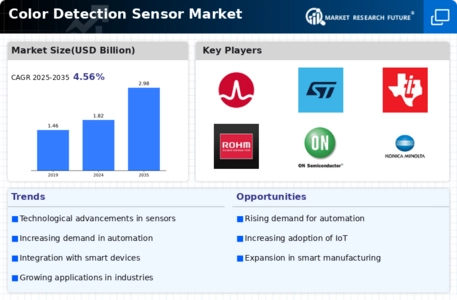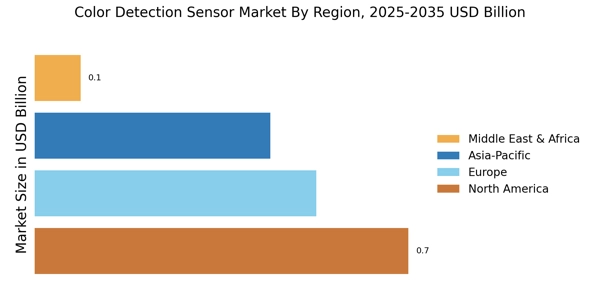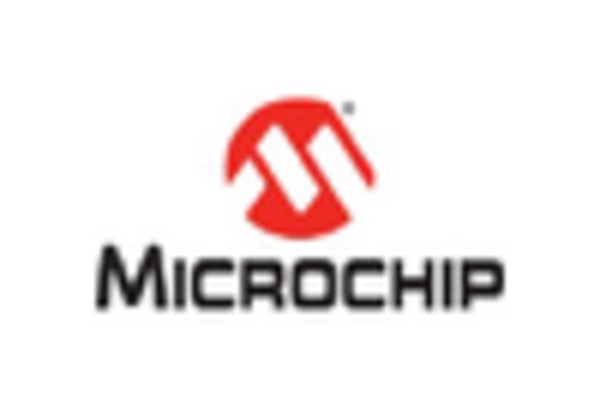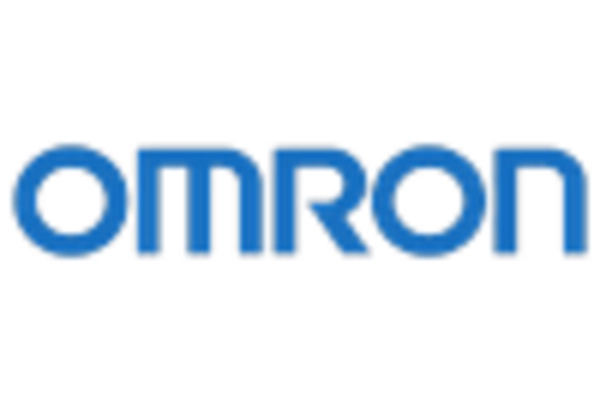The Color Detection Sensor Market is currently characterized by a dynamic competitive landscape, driven by technological advancements and increasing demand across various sectors, including consumer electronics, automotive, and industrial automation. Key players such as Texas Instruments (US), Omron (JP), and Honeywell (US) are strategically positioned to leverage their extensive R&D capabilities and market presence. Texas Instruments (US) focuses on innovation in sensor technology, particularly in enhancing the accuracy and efficiency of color detection systems. Meanwhile, Omron (JP) emphasizes regional expansion and partnerships to strengthen its foothold in emerging markets, while Honeywell (US) is actively pursuing digital transformation initiatives to integrate advanced analytics into its sensor solutions. Collectively, these strategies contribute to a competitive environment that is increasingly centered around technological differentiation and customer-centric solutions.
In terms of business tactics, companies are localizing manufacturing and optimizing supply chains to enhance responsiveness to market demands. The Color Detection Sensor Market appears moderately fragmented, with a mix of established players and emerging entrants. The collective influence of key players is significant, as they not only drive innovation but also set industry standards that smaller companies often follow. This competitive structure fosters an environment where collaboration and strategic partnerships are essential for sustained growth.
In August 2025, Texas Instruments (US) announced the launch of a new line of color detection sensors designed for automotive applications, which is expected to enhance vehicle safety and user experience. This strategic move underscores the company's commitment to innovation and its focus on high-growth sectors. By integrating advanced color detection capabilities into automotive systems, Texas Instruments (US) positions itself as a leader in a niche market that is likely to see increased demand as automotive technology evolves.
In September 2025, Omron (JP) expanded its partnership with a leading robotics manufacturer to integrate color detection sensors into automated systems for manufacturing processes. This collaboration is strategically significant as it not only enhances the functionality of robotic systems but also aligns with the growing trend of automation in industrial settings. By leveraging its expertise in sensor technology, Omron (JP) is likely to capture a larger share of the industrial automation market, which is increasingly reliant on precision and efficiency.
In July 2025, Honeywell (US) unveiled a new suite of smart color detection sensors aimed at the smart home market. This initiative reflects Honeywell's strategic focus on digital transformation and the integration of IoT capabilities into its product offerings. By targeting the smart home segment, Honeywell (US) is positioning itself to meet the rising consumer demand for connected devices, thereby enhancing its competitive edge in a rapidly evolving market.
As of October 2025, current competitive trends in the Color Detection Sensor Market are heavily influenced by digitalization, sustainability, and the integration of artificial intelligence. Strategic alliances are increasingly shaping the landscape, as companies recognize the value of collaboration in driving innovation and expanding market reach. Looking ahead, competitive differentiation is expected to evolve, with a notable shift from price-based competition to a focus on technological innovation, reliability in supply chains, and the ability to deliver customized solutions that meet specific customer needs.

















Leave a Comment